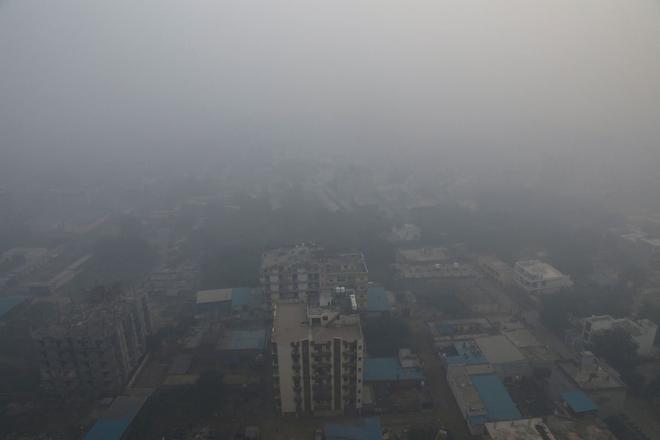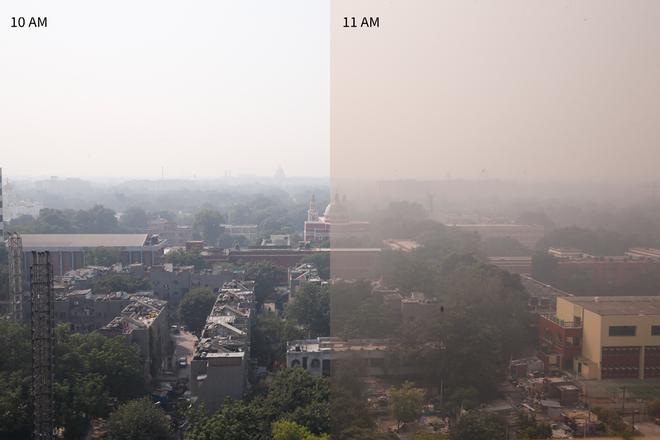


The story so far: A revised action plan to fight the serious challenge of air pollution in Delhi and the National Capital Region (NCR) has come into force after a sudden dip in air quality in the capital and its neighbouring areas.
On October 6, the first stage of the revised Graded Response Action Plan, or GRAP, was implemented, with the Commission for Air Quality Management (CAQM) asking the authorities in Delhi-NCR to enforce strict measures, including a ban on all construction and demolition activities in plots of sizes equal to or more than 500 square metres that aren’t registered on government-mandated web portals.
To deal with the multi-faceted risks linked to air pollution, the Central Pollution Control Board (CPCB) submitted a list of measures to address different levels of air pollution to the Supreme Court in January 2016. These measures coalesced into a Graded Response Action Plan — a set of anti-air pollution measures followed in Delhi and its vicinity according to the severity of the situation.
The GRAP was approved by the SC after modifications and notified by the Ministry of Environment, Forests and Climate Change on January 12, 2017, for the “prevention, control and abatement” of air pollution in Delhi-NCR. The Environment Pollution (Prevention and Control) Authority (EPCA) was the designated agency to implement the plan.
With multiple State and central bodies working on the problem, a need was felt to consolidate resources to efficiently tackle the problem of toxic air. In 2020 and 2021, ordinances were promulgated for the constitution of a commission for “better coordination, research, identification, and resolution of problems related to air quality” in the NCR and adjoining areas in Haryana, Punjab, Rajasthan and Uttar Pradesh. On August 12, the Commission for Air Quality Management in NCR and Adjoining Areas Act, 2021 received the President’s assent. The Centre dissolved EPCA and set up the Commission for Air Quality Management in National Capital Region and Adjoining Areas.
The powerful body, which coordinates with other States to plan and execute strategies to prevent and control air pollution in the NCR, has been enforcing the GRAP since 2021.
On August 5, the Commission for Air Quality Management issued statutory directions for the implementation of the revised schedule of the GRAP. Under the revised action plan, restrictions on polluting activities will be dependent on Air Quality Index (AQI) rather than PM2.5 and PM10 concentration. Measures can be taken up to three days in advance based on forecasts, the revised plan states.
Earlier, measures were implemented only after the PM2.5 and PM10 concentrations (micrograms per cubic metre) reached a certain threshold.
As per experts, the “finer” version of GRAP could prevent the air quality crisis in Delhi-NCR after Diwali. “Stubble burning peaks in November and Diwali is on October 24. This is a crucial factor. So, it may not lead to a severe situation on Diwali provided all other measures are followed strictly…The government has provided more machines for the management of stubble this year. We hope for better results,” Dr Mahesh Narang, the head of the farm engineering department at Punjab Agricultural University told PTI.
The GRAP for Delhi-NCR is divided into four stages of air quality — Stage 1 for “poor” Air Quality Index (AQI) ranging between 201 and 300, Stage 2 for “very poor” AQI of 301-400, Stage 3 for “severe” AQI of 401-450 and Stage 4 for “severe plus” AQI more than 450. As per the plan, actions under Stages 2-4 are invoked at least three days in advance of the AQI reaching the projected levels.
Stage 1: In this stage, besides a ban on construction and demolition activities at specific sites, agencies must ensure that all solid waste is lifted from dedicated dump sites, and none is dumped on open land. Heavy fines are to be imposed for openly burning municipal solid waste and biomass. Roads will be mechanically cleaned and water sprinkled from time to time.
Authorities, meanwhile, will ensure that thermal power plants comply with emission norms and that industries use approved fuel. Guidelines for use of anti-smog guns at construction sites are also to be issued. The ban on firecrackers should be followed as per the directions of respective courts.
Social media is to be used to update people about pollution levels and control room contact details so that violations can be reported to the authorities.
Stage 2: In stage 2, mechanised sweeping of roads will be done daily, while water will be sprinkled using dust suppressants at least on alternate days. The use of coal and firewood in eateries would bebanned.
Authorities would need to ensure an uninterrupted power supply to discourage the use of generators. Diesel generators might be allowed onlyin certain cases. Parking fees may be raised to discourage private transport. Resident Welfare Associations would be required to provide electric heaters to security staff during winter to prevent the burning of solid waste or biomass.
Stage 3: The frequency of cleaning roads intensifies in this stage. Water would be sprinkled daily before peak traffic hours. Authorities will levy different rates on public transport services to encourage off-peak travel. A strict ban will beenforced on all construction activities, except ongoing construction of railway, metro, airport and hospital projects. Non-polluting activities like plumbing, interior decoration and electrical works, however, would be permitted. Industries not using approved fuels would be allowed to operate only for a maximum of five days a week. The State government will be empowered to impose restrictions on BS-III petrol and BS-IV diesel light motor vehicles (4-wheelers).
Stage 4: When the air quality rises to dangerous levels, entry of all trucks except those carrying essential commodities, or providing essential services is to be stopped into Delhi. This will be followed by a ban on plying of diesel-operated medium goods and heavy goods vehicles in Delhi, except those carrying essential items. Four-wheeler diesel LMVs would also banned in the NCT of Delhi and Districts of NCR bordering Delhi, except those used for essential or emergency services. All construction and demolition activities would have to be stopped.

The respective governments could, meanwhile, take a call on allowing public, municipal and private offices to work on 50% strength. If required, the Centre can allow work from home for central government employees.
Additional emergency measures like closing schools and other educational institutes, non-emergency commercial activities and plying of vehicles on an odd-even basis may also be enforced.
Along with instructions for authorities, the GRAP includes a graded advisory for the public. Measures include properly tuning the engines of their vehicles, ensuring accurate air pressure in tyres and updating PUC (pollution under control) certificates. “Do not idle your vehicle and turn off the engine at red lights; do not dispose of waste or garbage in open spaces; report air pollution activities through apps 311, Green Delhi, SAMEER,” instructions under Stage 1. read.
For Stages 2, 3 and 4, the Commission advises the public to opt for public transport, or work from home if required.
Children, the elderly and those with respiratory, cardiovascular, cerebrovascular or other chronic diseases are advised to avoid outdoor activities and stay indoors once Stage 4 is implemented.
Besides GRAP, the Arvind Kejriwal-led AAP government in Delhi has also launched a 15-point action plan this year to tackle the issue of pollution in NCR. As per Delhi Environment Minister Gopal Rai, the winter action plan will focus on stubble management, dust pollution, vehicular emission, open burning of garbage, industrial pollution, pollution hotspots, smog towers, public participation, firecrackers and joint action with neighbouring states among other aspects.
Measures include the installation of anti-smog guns at construction and demolition sites larger than 5,000 square metres. Earlier, such guns were deployed in sites larger than 20,000 sq m. Over 500 teams will be formed to check the burning of garbage in the open and ensure that the GRAP is implemented on construction sites in the city. The Delhi government has also launched an “advanced Green War Room” to monitor air pollution and ensure effective implementation of its winter action plan”.
